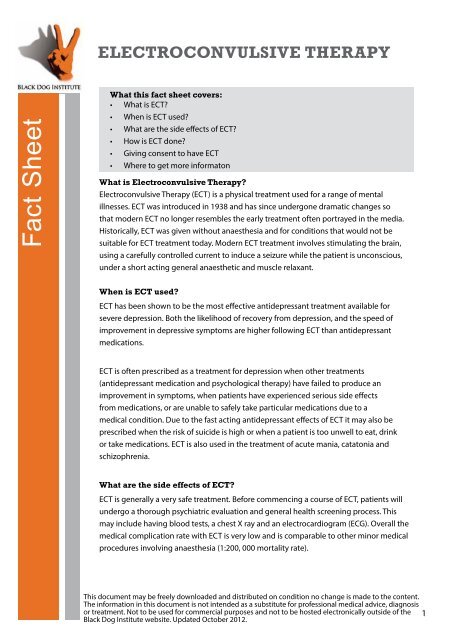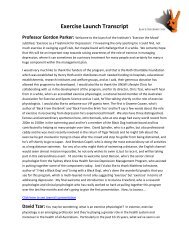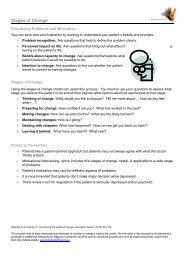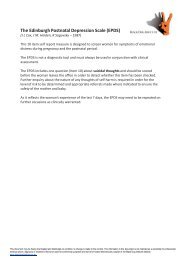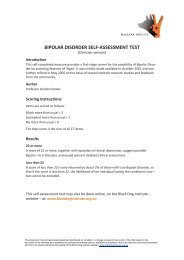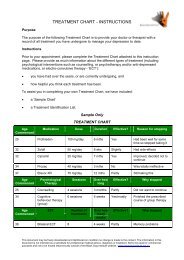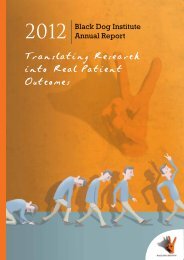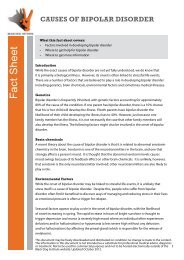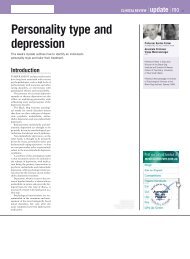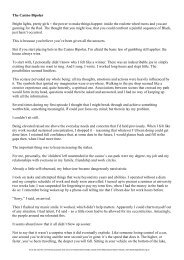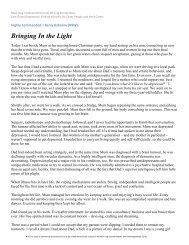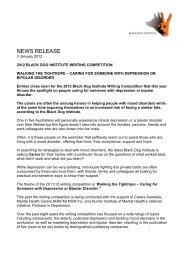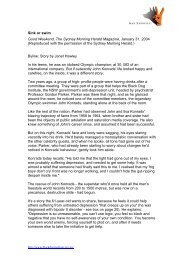ECT - Black Dog Institute
ECT - Black Dog Institute
ECT - Black Dog Institute
You also want an ePaper? Increase the reach of your titles
YUMPU automatically turns print PDFs into web optimized ePapers that Google loves.
Electroconvulsive Therapy<br />
Fact Sheet<br />
What this fact sheet covers:<br />
• What is <strong>ECT</strong>?<br />
• When is <strong>ECT</strong> used?<br />
• What are the side effects of <strong>ECT</strong>?<br />
• How is <strong>ECT</strong> done?<br />
• Giving consent to have <strong>ECT</strong><br />
• Where to get more informaton<br />
What is Electroconvulsive Therapy?<br />
Electroconvulsive Therapy (<strong>ECT</strong>) is a physical treatment used for a range of mental<br />
illnesses. <strong>ECT</strong> was introduced in 1938 and has since undergone dramatic changes so<br />
that modern <strong>ECT</strong> no longer resembles the early treatment often portrayed in the media.<br />
Historically, <strong>ECT</strong> was given without anaesthesia and for conditions that would not be<br />
suitable for <strong>ECT</strong> treatment today. Modern <strong>ECT</strong> treatment involves stimulating the brain,<br />
using a carefully controlled current to induce a seizure while the patient is unconscious,<br />
under a short acting general anaesthetic and muscle relaxant.<br />
When is <strong>ECT</strong> used?<br />
<strong>ECT</strong> has been shown to be the most effective antidepressant treatment available for<br />
severe depression. Both the likelihood of recovery from depression, and the speed of<br />
improvement in depressive symptoms are higher following <strong>ECT</strong> than antidepressant<br />
medications.<br />
<strong>ECT</strong> is often prescribed as a treatment for depression when other treatments<br />
(antidepressant medication and psychological therapy) have failed to produce an<br />
improvement in symptoms, when patients have experienced serious side effects<br />
from medications, or are unable to safely take particular medications due to a<br />
medical condition. Due to the fast acting antidepressant effects of <strong>ECT</strong> it may also be<br />
prescribed when the risk of suicide is high or when a patient is too unwell to eat, drink<br />
or take medications. <strong>ECT</strong> is also used in the treatment of acute mania, catatonia and<br />
schizophrenia.<br />
What are the side effects of <strong>ECT</strong>?<br />
<strong>ECT</strong> is generally a very safe treatment. Before commencing a course of <strong>ECT</strong>, patients will<br />
undergo a thorough psychiatric evaluation and general health screening process. This<br />
may include having blood tests, a chest X ray and an electrocardiogram (ECG). Overall the<br />
medical complication rate with <strong>ECT</strong> is very low and is comparable to other minor medical<br />
procedures involving anaesthesia (1:200, 000 mortality rate).<br />
This document may be freely downloaded and distributed on condition no change is made to the content.<br />
The information in this document is not intended as a substitute for professional medical advice, diagnosis<br />
or treatment. Not to be used for commercial purposes and not to be hosted electronically outside of the 1<br />
<strong>Black</strong> <strong>Dog</strong> <strong>Institute</strong> website. Updated October 2012.
Electroconvulsive Therapy<br />
Fact Sheet<br />
A brief period of confusion following <strong>ECT</strong> is relatively common. Some people may experience<br />
a headache or nausea and these side effects can be treated with medication if necessary.<br />
Muscle soreness or aching can also occur after <strong>ECT</strong> as a result of the medications<br />
given to relax muscles during <strong>ECT</strong>. These effects are transient, usually lasting only a few<br />
hours after the <strong>ECT</strong>.<br />
<strong>ECT</strong> can cause temporary memory loss. Specifically, some patients experience difficulties<br />
laying down new memories during the course of <strong>ECT</strong> and may be unable to remember<br />
events which occurred during this period. Evidence from research (Semkovska and<br />
McLoughlin, 2010) suggests that if memory and thinking are affected by <strong>ECT</strong>, the period<br />
of memory problems is relatively brief and test scores have usually returned to pre-<strong>ECT</strong><br />
levels one month after treatment.<br />
Sometimes occasional memories from the past may be forgotten. It is also important to<br />
note that many patients suffering from depression already have problems with attention,<br />
concentration, thinking and memory prior to commencing <strong>ECT</strong>. It is not uncommon for<br />
patients to report that their memory is better following <strong>ECT</strong>.<br />
The safety of <strong>ECT</strong> has also been examined with detailed brain scans done before and after<br />
<strong>ECT</strong>. There is no evidence that <strong>ECT</strong> causes brain damage.<br />
How is <strong>ECT</strong> done?<br />
<strong>ECT</strong> is usually performed in an operating suite, so that there is easy access to specialist<br />
anaesthetic services. The anaesthetist and <strong>ECT</strong> nurses will connect monitoring equipment<br />
to check a patient’s heart rate, blood pressure, oxygen levels, and brain waves. The<br />
anaesthetist will then insert a small needle into a vein in the hand, to provide anaesthetic.<br />
While going off to sleep, the anaesthetist will also provide oxygen to breathe.<br />
Once fully asleep and relaxed, a doctor will give the <strong>ECT</strong> stimulus (which usually lasts<br />
about five seconds). This will induce a seizure that lasts about a minute, with minimal<br />
muscle movement. After this, patients gradually regain consciousness and are taken to the<br />
recovery area where a nurse will monitor heart rate, blood pressure, etc. until the patient is<br />
fully awake. The whole process takes around half an hour, and the patient may feel groggy<br />
for a while due to the seizure and the anaesthetic.<br />
Giving consent to <strong>ECT</strong><br />
As with any other significant medical procedure, before the <strong>ECT</strong> can be done, patients will<br />
be asked to give consent or permission for it to go ahead. Consent needs to be ‘informed’<br />
– that is, the reasons for doing it, and the possible risks and benefits should be explained<br />
fully in a way that is understood. Patients have the right to ask questions regarding the<br />
procedure, and to discuss their views with their psychiatrist. After this is done, patients are<br />
This document may be freely downloaded and distributed on condition no change is made to the content.<br />
The information in this document is not intended as a substitute for professional medical advice, diagnosis<br />
or treatment. Not to be used for commercial purposes and not to be hosted electronically outside of the 2<br />
<strong>Black</strong> <strong>Dog</strong> <strong>Institute</strong> website. Updated October 2012.
Electroconvulsive Therapy<br />
Fact Sheet<br />
asked to sign a consent form that states that <strong>ECT</strong> has been explained to them, that they<br />
understand what is going to happen, and that they consent to it. Patients can, however,<br />
withdraw their consent at any point if they wish – even before the first treatment.<br />
There may be cases sometimes where people are too unwell to make a decision about<br />
having <strong>ECT</strong>. For example, they may be so severely withdrawn or have ideas about<br />
themselves that stop them taking on board all the issues surrounding <strong>ECT</strong> (e.g. they may<br />
wrongly believe that their depression is a punishment they deserve for something they<br />
have done). If this happens, it may be impossible for them to give informed consent. In<br />
this case, <strong>ECT</strong> can still be given under the Mental Health Act – this is a strictly controlled<br />
process regulated by law, with input from independent clinical and legal experts, and<br />
takes into account the view of the patient and their family.<br />
Where to get more information:<br />
• <strong>ECT</strong> Policy from NSW Health – Especially Appendix 1. www.health.nsw.gov.au/<br />
policies<br />
• New development of ultrabrief pulse width <strong>ECT</strong>: Loo, C. (2013). <strong>ECT</strong> in<br />
the 21st Century: Ultrabrief pulse stimulation – a new development in treatment<br />
technique. Australian Prescriber, 36(1) 22-23<br />
• Role of <strong>ECT</strong> in the treatment of depression, from the UK National<br />
<strong>Institute</strong> of Clinical Excellence: NICE Clinical Guidelines, The treatment and<br />
management of depression in adults. guideline.nice.org.uk/cg90, October 2009<br />
• Patients’ perspectives: Rose, D., Fleischmann, P., Wykes, T., Leese, M. & Bindman J.<br />
(2003). Patients’ perspectives on electroconvulsive therapy: Systematic review. British<br />
Medical Journal, 326, 1363<br />
• Review of <strong>ECT</strong> effects on memory: Semkovska, M. & McLoughlin, D. M. (2010).<br />
Objective cognitive performance associated with electroconvulsive therapy for<br />
depression: A systematic review and meta-analysis. Biological Psychiatry, 68, 568-577<br />
• Review of <strong>ECT</strong> efficacy: UK <strong>ECT</strong> Review (2003). Efficacy and safety of<br />
electroconvulsive therapy in depressive disorders: A systematic review and metaanalysis<br />
. Lancet, 361, 799-808<br />
<strong>Black</strong> <strong>Dog</strong> <strong>Institute</strong><br />
Hospital Road, Prince of Wales Hospital, Randwick NSW 2031<br />
(02) 9382 4530 Email: blackdog@blackdog.org.au<br />
www.blackdoginstitute.org.au<br />
This document may be freely downloaded and distributed on condition no change is made to the content.<br />
The information in this document is not intended as a substitute for professional medical advice, diagnosis<br />
or treatment. Not to be used for commercial purposes and not to be hosted electronically outside of the 3<br />
<strong>Black</strong> <strong>Dog</strong> <strong>Institute</strong> website. Updated October 2012.


